“As settlers are non-indigenous, they are forever indigenising. . . The question then is how to be efficient self-indigenisers.”[1]
In 2008 the first Palestinian wine made from indigenous grapes was released, introducing a discourse of primordial place-based authenticity into the local wine field. Six years later, Israeli wineries started marketing a line of indigenous wines. Since then, a growing number of Palestinian and Israeli winemakers and scientists have been using the research, production and marketing of indigenous wines to bolster their historical claims to the land. These producers have emerged in a global era in which terroir—defined as an idiosyncratic combination of soil, climate, culture and history that gives food its distinct taste—shapes economic and cultural value. Against the dominance of international grape varieties, the indigenous turn in the wine world is mobilizing genetics, enology and ancient texts to rewrite the Israeli and Palestinian landscapes.
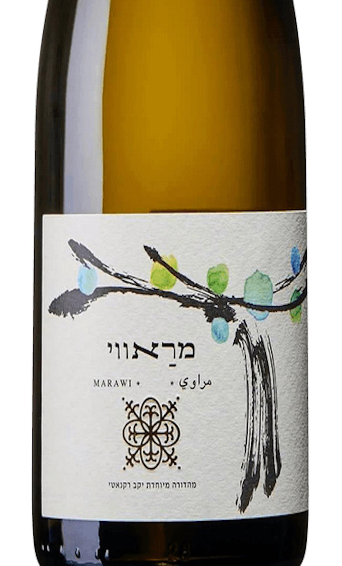
The trilingual Marawi label on the Recanati Winery’s “ancient wines” series. Daniel Monterescu, 2018.
Already available on the local market, the first Palestinian indigenous wine made its international debut in 2013 at a special tasting of wines from the Holy Land in London. The globally renowned Master of Wine Jancis Robinson conducted the baptismal ritual and awarded the highest score, 16.5, to the Cremisan Winery’s Star of Bethlehem Hamdani Jandali 2011, a blend of two indigenous grape varieties (hamdani and jandali). Later she confessed it was the first time she had tasted Palestinian wine.
After this success, the Israeli Recanati Winery launched Marawi 2014, produced from the hamdani (also known as marawi) grapes of an anonymous Palestinian vintner in the Bethlehem area. In October 2015, shortly after the beginning of the Hebrew calendar year, Haaretz named Recanati’s Marawi 2014 the “Most Important Wine of the Year.” The paper’s wine critic admitted that his selection was chosen not for its exceptional quality but for its cultural and historical uniqueness. “The Marawi 2014 is the first commercial Israeli wine produced from a local, indigenous variety with roots in antiquity,” he wrote. “As such, it will eventually be recorded in the annals of Israeli wine.”[2]
Tellingly, it was not the Palestinian wine but the Israeli newcomer that won broad attention in the international press. “Israel Aims to Recreate Wine That Jesus and King David Drank,” declared the New York Times.[3] Channel 7, an Israeli national religious news station, claimed that research on indigenous grapes “will restore the wines of the Holy Temple.”[4] The China Daily, covering a master class in Beijing, referred (inaccurately) to the marawi grape as “the first indigenous grape re-created with DNA technology, thanks to preserved samples of grape tissue at least 2,000 years old.”[5]
Far from being an innocent drink, Israelis use indigenous wine to help refute the claim that they are settlers and to claim ancestral Jewish ties to the land. Israeli winemakers have, however, adopted the grape varieties that Palestinians have been growing for centuries in an unbroken Christian village tradition of winemaking. Dire economic conditions due to the ongoing Israeli occupation of the West Bank oblige Palestinian vintners to rely on uncooperative Israeli authorities to export their wines and has pushed many to sell their grapes to winemakers in Israel and in Jewish settlements. Despite these difficulties, some Palestinian wineries are succeeding in producing indigenous wine and in the process are strengthening their traditional connections to the land. The experiences of both Israeli and Palestinian winemakers’ use of endemic grape varieties illustrates the power of science, craft and taste to reconfigure the human and nonhuman politics of settler colonialism.
The Power of Food and Wine
Settler colonialism is primarily about seizing land and maintaining the power to use it. Controlling agricultural production, distribution and marketing, the dominant group appropriates indigenous lands to produce food to sustain its own polity. Food, however, is not merely about consumption and sustenance, it is also a marker of identity: Certain foods are widely recognized as national icons. Some are regulated by authorities (such as the European Union) and can only be produced in a specific location with a “protected designation of origin,” such as some cheeses or wines like Parmesan and Champagne. As part of patriotic traditions, food expresses power relations and sometimes exposes dark aspects of national culture, such as xenophobia and racism. In extreme cases, gastronationalism, or the assertion of cultural ownership of types of food by a particular nation, may lead to border disputes, trade wars and reciprocal attempts to limit production and to control labeling rights.[6]
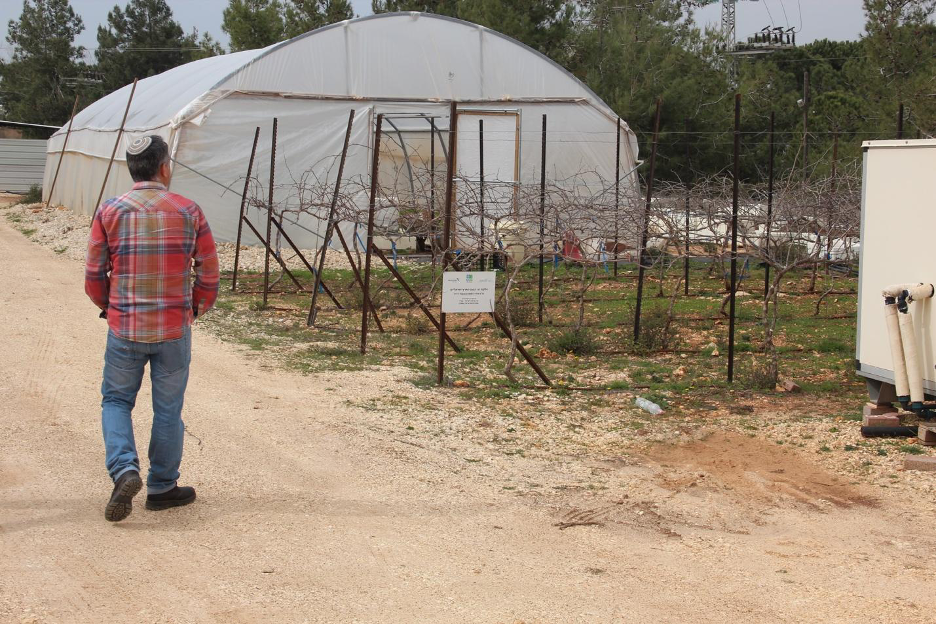
Elyashiv Drori walks across his research vineyard at Ariel University. The signpost acknowledges the financial support of Ariel University, the Jewish National Fund, the Samaria Region and the Jordan Valley Research and Development Center for his “Israeli grapevine varieties.” Daniel Monterescu 2018
The global wine economy’s central concept of uniqueness is that of terroir. In contrast to modern conceptions of territory as an abstract legal and political entity, terroir conjures images of an organic connection between people and land, producing a distinct character and “typicity.” To capture the French notion of goût de terroir, food anthropologist Amy Trubek characterizes terroir as the “taste of place.”[7] The discourse of terroir has seeped into Israeli and Palestinian wine culture since boutique wineries first emerged in the 1990s and plays a major role in narratives about the special history of the land. Terroir has thus become a political project of establishing a space of unique quality that enhances the capitalist logic of the consumer market.[8]
The Zionist claim, which can be described as “a terroir without people for a people without terroir,” seeks to write out non-Jewish narratives. In contrast to the production of other agricultural commodities, such as olives, wheat and tomatoes, wine production is framed in the Israeli discourse exclusively in terms of Jewish history. The omnipresence of wine in the Bible and in Jewish tradition, coupled with the Muslim prohibition against drinking alcohol, perfectly pairs the teleological story of local wine with hegemonic Zionist motifs: from ancient sovereignty, exile and return to modern sovereignty, creation and innovation. The marawi or hamdani grape plays a role in this quest for the holy grail of indigenous authenticity in a colonial space inhabited by two populations fighting over the question of who was there first.
When winemakers connect indigenous grapes to the wine that Jesus drank at the last supper—as advertised when the wine is marketed internationally to non-Jewish customers—or to the wines served at King David’s table, the local varieties become emblematic of political place and historical roots. Ultimately, for both Jewish Israelis and Palestinians, reconstructing indigenous wines is also a practice of reviving national identity and inventing tradition.
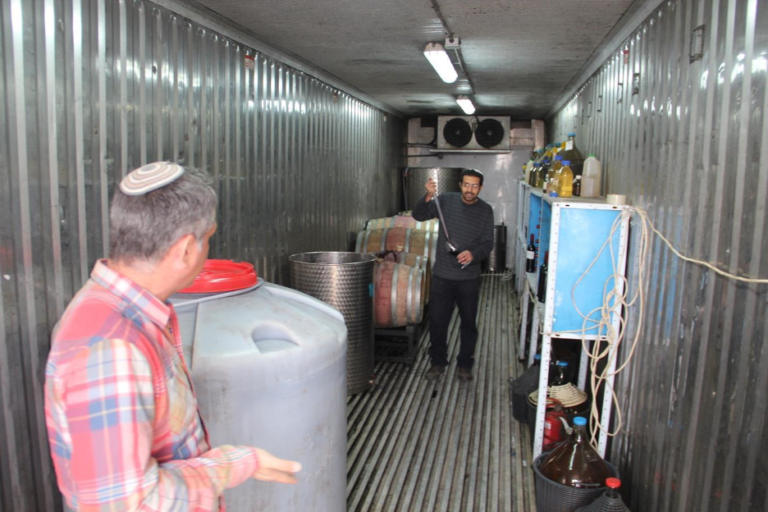
Elyashiv Drori (left), a molecular biologist, at work in his research winery at Ariel University in the West Bank. An assistant winemaker removes a tasting sample from a barrel. Daniel Monterescu, 2018.
For example, Elyashiv Drori, a molecular biologist at Ariel University (an Israeli university attached to an illegal settlement in the West Bank) set up a research laboratory and experimental vineyard with a grant from the Jewish National Fund to find the connections between indigenous grapes and Jewish history. For Drori, a Jewish settler and a major player in the scientific project of mapping and recovering native species, the goal of his project is no less than to “create an identity.” He explains that,
People ask me about the purpose of the research. I tell them that the goal was almost ideological. The goal was to create an identity for the Israeli wine industry, which is now struggling and debating and not knowing exactly what it is. [. . .] Our scriptures are filled with wine and grapes. We have a very ancient identity, and for me it is very important to restore this identity. It is a matter of national pride.[9]
Following the indigenous turn in the local wine field, Israeli and Palestinian scientists and winemakers compete over the singular value of the grape as an object that is both natural and biological as well as human and cultural. This project combines different types of knowledge. Scientists use DNA analysis and genetic mapping to scientifically prove biological continuity. Scholars collect local and indigenous knowledge through the oral testimonies of elderly Palestinian farmers. Historians analyze ancient Arabic and Hebrew texts to identify taste, color, alcohol concentration and ancient winemaking techniques. Practitioners of modern enology re-create and market wines with a story to tell. Professional wine experts hold tastings, write reviews in leading journals and participate in international competitions to secure the product’s marketing success.
Describing the indigenous wine field therefore involves exploring the chemistry, biology and distribution of the cultivar, as well as scrutinizing the history and political economy of its production. Ultimately, such an examination sheds light on the paradox inherent in the settler-colonial situation in Israel and Palestine, which subordinates Palestinian indigeneity to the Israeli quest for rooted identity.
Reverse Engineering the Indigenous Vine
Although the Israeli wine industry presents itself as the pioneer of native wine research and marketing, Palestinian experimentation with indigenous varieties has a long history. Today, Palestinian winemakers exemplify two fundamental aspects of the process of reverse engineering the native vine: precedent and continuity. Cremisan Winery, located in the Salesian Monastery on the outskirts of Beit Jala (just outside Bethlehem), has produced wine since 1885; that is, earlier than the winery established by Baron Edmund de Rothschild, the Jewish Zionist philanthropist who planted vineyards in Palestine with French varieties in the 1890s. Cremisan set a precedent by launching its indigenous wine series first, six years before Recanati produced wine with marawi grapes in 2014. Another Palestinian wine producer, Taybeh Winery, located northeast of Ramallah, emphasizes historical continuity in its reliance on local knowledge and varietal terroir to continue an uninterrupted Christian tradition that requires no “reconstruction.”
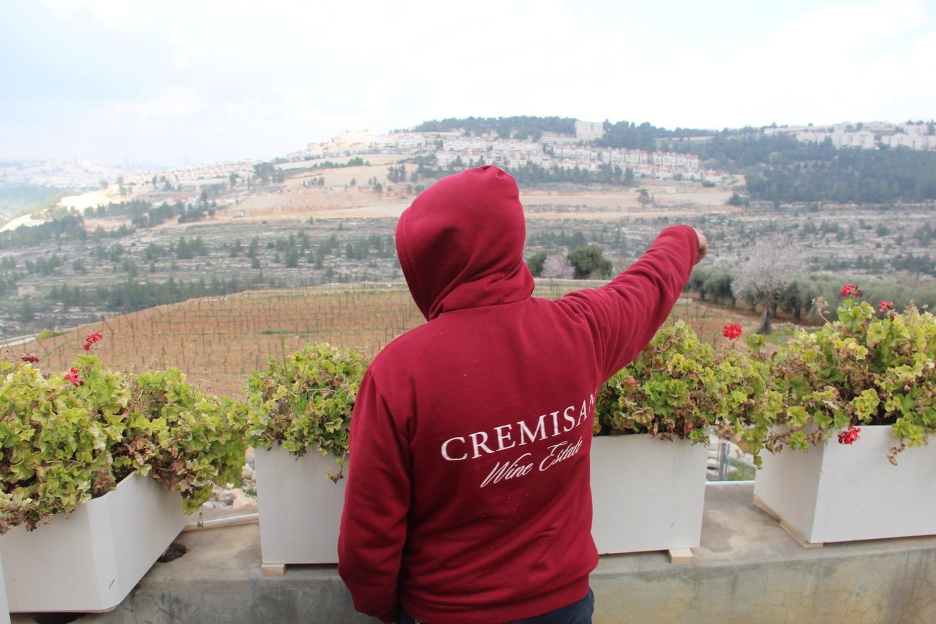
In the northern hills of the West Bank, winemaker Fadi Batarseh points across the Cremisan Valley at the Israeli settlement Har Gilo, south of Jerusalem and close to Bethlehem. Daniel Monterescu, 2017.
Under the supervision of renowned Italian winemaker Riccardo Cotarella, Cremisan features a portfolio of three native wines: baladi, dabouki and jandali-hamdani. The winery identifies itself as Palestinian. Israeli restrictions on movement and control over the Palestinian economy, however, make it difficult to export goods from Palestine, forcing its owners to cooperate with Jewish Israeli partners. At Cremisan since 2013, winery manager and chief agronomist Fadi Batarseh laments the need to export to Europe and the United States via Israel, but he must comply to survive economically.
Cremisan is leading the Palestinian enological efforts to revive endemic varieties, predominantly used as table grapes during the Islamic era. Seeking to identify the molecular character of local grapes, the winery strives for the perfect fit between terroir and cultivar. Like its Jewish Israeli rivals, Cremisan emphasizes its local identity and heritage. Trained in enology in Udine, Italy, Batarseh was part of an international research team working on “Molecular Identification and Genetic Relationships of Palestinian Grapevine Cultivars.”[10] These attempts mark the new frontiers of Palestinian wine science in its search for place-based authenticity.
Amer Karadosh, Cremisan’s sales manager, stresses the Palestinian provenance of indigenous grapes and calls out Israeli cultural appropriation: “As usual in Israel, they declare that falafel, tahini, tabouleh, hummus and now Jandali grapes are an Israeli product. I would like to inform you that these types of grapes are totally Palestinian grapes grown on Palestinian vineyards.”[11] During our stay in the winery, Batarseh concluded bitterly, “Israel can do whatever it wants. Nobody can stop them. But for me it does not matter. We do our work, and we’re glad we have the opportunity to do it. I leave the politics to them. I make my wine.” Yet, like all industrial enterprises in the West Bank, Cremisan does not have the luxury to ignore the political reality of Israeli colonization. Batarseh is deeply concerned with the construction of the separation barrier, approved by the Israeli Supreme Court in July 2015 despite papal opposition, which will cut through the Cremisan valley. “It hasn’t affected us yet, but it will very soon,” Batarseh said, pointing at the settlement Har Gilo across the valley. Local grassroots groups, legal activists and religious leaders have resisted the barrier, but so far they have been unable to stop its construction.
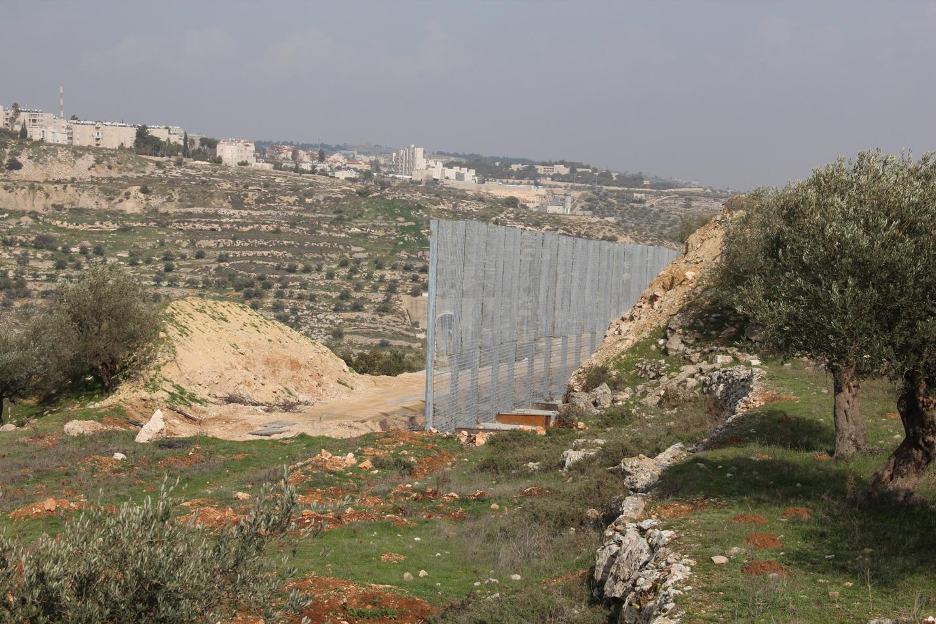
The Israeli separation barrier cuts through the Cremisan monastery’s fields in the West Bank. Daniel Monterescu, 2017.
The second major player in the Palestinian wine field is Taybeh Winery, established in 2013. Unlike Cremisan’s publicity materials, which hardly mention the political situation in the West Bank, Taybeh Winery refers to the Israeli occupation as an integral part of its terroir narrative. According to Taybeh’s chief winemaker, Canaan Khoury, “It is impossible to be apolitical. You must be political.” Israeli confiscation of Palestinian lands, the disparities in water access between Palestinians and Jewish settlers, the military checkpoints that prevent grape transport and wine export and ultimately Israeli attempts to erase their indigenous ties to Palestine—all of these realities are part of the brand’s story and identity. These conditions also affect Taybeh’s brewery. In competition with international beer brands, its local billboards bear the slogan “Drink Palestinian: Taste the Revolution.”[12] Despite the marketing challenges, the company also makes sure to add the name Palestine on the label. (Cremisan’s label mentions only West Bank to comply with US import requirements.) While the Palestinian origins of its products have become part of his marketing strategy, Khoury insists that politics are not Taybeh’s main selling point: “I can sell wine or beer in America as a Palestinian product,” he says, “but if it’s not a quality drink, they will not continue to buy it, and it’s not sustainable.”
Taybeh’s decision to cultivate indigenous varieties began as a result of constraints in transporting grapes across the West Bank during the Second Intifada (2000–2005). This challenge led the winery to focus on local native cultivars. Only later did it evolve into a philosophy of authentic winemaking and a marketing strategy. “When internationals come and I say, ‘We make indigenous wines;’ they don’t want to try a chardonnay from Palestine,” Khoury says. “Most of them want to try the zeini.” Khoury guided us through his repeated failures to list local species (such as zeini, bitouni and balouti) as Palestinian grape varieties, referring to what he perceives as an absurdity: In the European Union’s certified grape variety database, the staff at Ariel University has registered a grape variety called Hebroni as an Israeli species.
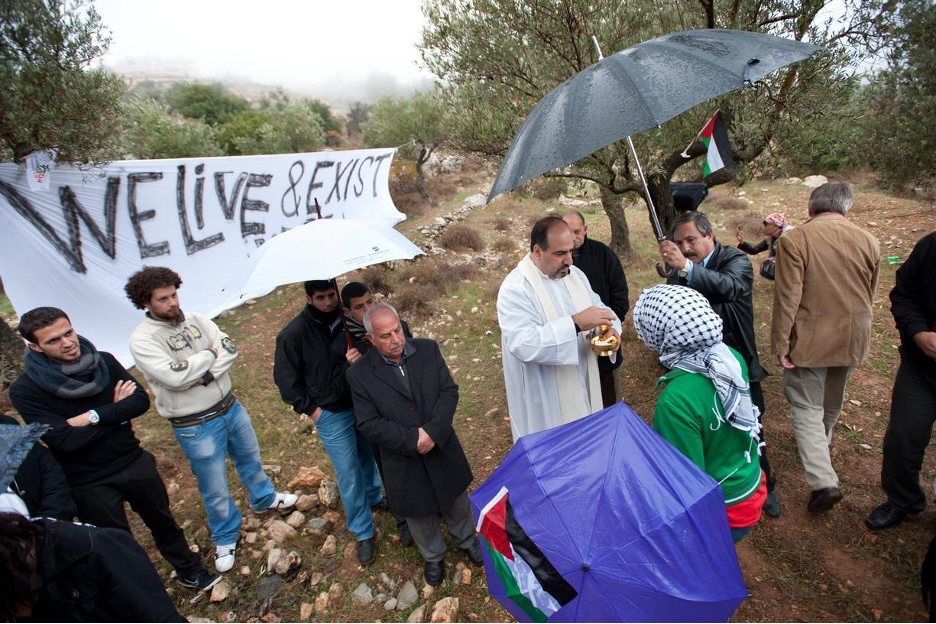
Under the banner “We live and exist here,” Bethlehem-area Christians and solidarity activists celebrate Mass to protest the Israeli separation wall that will cut off the Cremisan monastery and winery from nearby Palestinian communities. Ryan Rodrick Beiler, 2011.
Khoury studied enology at the University of California, Davis after graduating with a degree in engineering from Harvard. He defines himself as a “man of science” and reiterates throughout our encounters that terroir is about not only physical conditions (topography, climate, soil) but also traditional viticultural practices, which he tries to preserve and improve. Taybeh is an ancient Christian village with a long winemaking tradition. “I want to see how my grandma used to make wine,” he says, “and how her grandmother used to make wine. And so that’s part of my personal journey.”
Cremisan and Taybeh are part of a proliferating movement of Palestinian wineries in Palestine and Israel. Questions of indigeneity and politics accompany all their enological and marketing decisions. In Taybeh Winery’s narrative, Jewish settlers cannot go native merely by mastering the technical means of wine production. Khoury is outraged that “a settler who came from New York, a lawyer who started a winery [in the West Bank], will tell me he wants to make a terroir wine when he knows nothing about the culture or the history or the way they produced it.” At Philokalia Winery, Sari Khoury makes wine from a 90-year-old vineyard that was destroyed by the Israeli military to pave a road to a Jewish settlement in the Bethlehem Governorate. The settlers used large stone boulders to crush the vines and then paved over them with asphalt. “Miraculously,” he says, “the vines grew back between the rocks, so I called the wine we made from them ‘grapes of wrath.’”[13] Other winemakers, such as Adam Kassis of Latroun Winery near Jerusalem and the small Domaine Kassis in Birzeit, are also exploring the potential of indigenous Palestinian varieties. Centering his attention on the dabouki (Arabic for “sticky”) cultivar, he is confident that he has found the perfect fit between the “true expression of terroir” and “the very ancient identity of the place:”
Dabouki might be the most ancient (2,500-3,000 years old) of the local Palestinian grape varieties and the most original of grapes; and its wine is a good candidate for what filled the glass of Pharaohs, kings and Jesus as well as guests at celebrations like, perhaps, the Wedding at Cana, as white wine was common back then as it is now. With Dabouki wine, the ancient transforms into the new and history reveals itself in the glass. And, after you taste the Domaine Kassis Dabouki wine, I think you will find, like me, that this is the most important awakening in thousands of years.[14]
In a settler-colonial setting, the Israeli side is “forever indigenizing,” while the Palestinians are thrown into an uneven competition that forces them to prove their own relationship to the land. In this context, indigenous wine has become a vehicle for mobilizing and stabilizing territorial claims. Palestinian and Israeli winemakers and scientists of various disciplines combine wine research and development, production and marketing with the aim of creating a new identity for the wine industry—and to a large extent, also for themselves. Indigenous wine is thus a contested site where gastronationalism, science and political economy meet. The terroir discourse embodies a passion for value, meaning and locality. Wine helps Jewish Israeli settlers imagine themselves as indigenous inhabitants of the land, even as it allows Palestinians to reclaim their own threatened traditions.
[Daniel Monterescu is associate professor of urban anthropology and food studies at the Central European University, Vienna. Ariel Handel is a researcher with the Lost Cities project (Cities Lost and Found: The Social Life of Ruins in Israel/Palestine, 1882 to the Present). Research for this article was made possible by the generous support of the Gerda Henkel Foundation.]
Endnotes
[1] Lorenzo Veracini, “What Can Settler Colonial Studies Offer to an Interpretation of the Conflict in Israel-Palestine?” Settler Colonial Studies 5/3 (2015) pp. 268–71.
[2] Itay Gleitman, “Is the New Marawi Wine, Made in Samaria from a Unique Local Variety, a Revelation for the Wine Industry?” Haaretz, October 23, 2015.
[3] Judi Rudoren, “Israel Aims to Recreate Wine That Jesus and King David Drank,” New York Times, November 29, 2015.
[4] Shimon Cohen, “The Study That Will Reconstruct the Wines of the Holy Temple,” Channel 7, March 26, 2014.
[5] Mike Peters, “The Toast of Israel,” China Daily, May 5, 2017.
[6] Daniel Monterescu, “Border Wines: Terroir across Contested Territory,” Gastronomica 17/44 (Winter 2017).
[7] Amy Trubek, The Taste of Place: A Cultural Journey into Terroir (Berkeley: University of California Press, 2008).
[8] Ariel Handel, Galit Rand and Marco Allegra, “Wine-Washing Colonization, Normalization, and the Geopolitics of Terroir in the West Bank’s Settlements,” Environment and Planning A 47/6 (June 2015).
[9] Fieldwork for this project took place in 2015–2017 in wineries across Israel and Palestine. The interview with Drori was conducted at Ariel University’s molecular biology department in February 2017.
[10] Rezq Basheer-Salimia, Silvia Lorenzi, Fadi Batarseh, Paula Moreno-Sanz, Francesco Emanuelli and M. Stella Grando, “Molecular Identification and Genetic Relationships of Palestinian Grapevine Cultivars,” Molecular Biotechnology 56/6 (June 2014).
[11] Judi Rudoren, 2015.
[12] Anne Meneley, “Resistance Is Fertile!” Gastronomica 14/4 (Winter 2014).
[13] For Sari Khoury, grapes of wrath is a reference to John Steinbeck’s 1939 novel, Grapes of Wrath. Anya Evans, “Palestinian Winemaking Under Occupation,” Open Democracy, October 19, 2017.
[14] “Domaine Kassis Dabouki Story,” LinkedIn, September 5, 2020.
